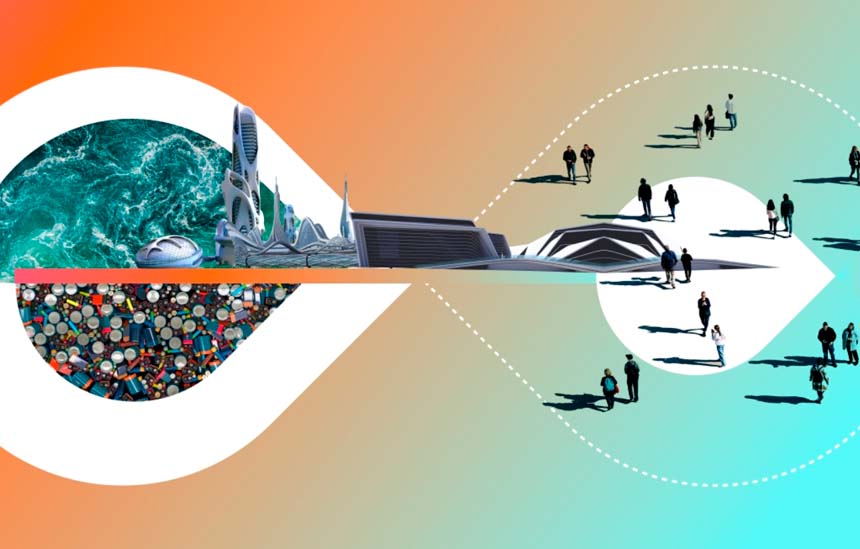Closing the loop to mitigate waste presents an opportunity to create new business streams that challenge current inefficiencies, leading to reduced emissions and economic growth.
The world is looking at ways to decrease the 100 billion tons of materials that are consumed annually. Nearly 92% of these materials – such as metals, plastics, wood, concrete and chemicals – are for single-use products.
The move to limit the amount of waste produced is beyond any one industry, product or country. Most items are not designed to be disassembled and mined for materials. Changing this isn’t just about protecting the environment, but – through the circular economy – it also presents a global growth opportunity.
In Saudi Arabia, NEOM has placed circularity as a key component in its development. The giga-project, located in the country’s northwest, is laying the foundation to challenge the linear model of today and instead has reimagined resource conservation, waste reduction and supply chain performance.
“It’s easier for NEOM to incorporate solutions that mitigate waste given that we are building from scratch, so we have the opportunity to do it from the start. Decoupling economic growth and the use of natural resources provides the opportunity for expansion, sustainably and financially,” Dr. Manar Al Moneef, Chief Investment Officer at NEOM.
Transforming the traditional take-make-waste system into a circular economy reduces the perpetual reliance on primary raw materials and the associated costs, leading to increased efficiency and profitability for investors. It’s also an opportunity for innovative services, which could help the circular economy generate US$4.5 trillion of additional economic output by 2030, according to a report from Accenture.
“Typically, when we think of saving materials – we think of financial gains from cost savings,” says Al Moneef. “Yes, the circular economy will pad the bottom line through savings, but you also find that working with what you have leads to new business opportunities.”
It’s a critical area of focus for investors as ESG becomes a must-have rather than a nice-to-have. The Ellen MacArthur Foundation, an international organization committed to the circular economy, highlighted assets managed through public equity funds with a circular economy focus increased 28-fold to just under $10 billion by November 2021 from $300 million from the end of 2019. Meanwhile, the annual issuance of corporate and sovereign bonds increased five-fold.
For NEOM, being a living laboratory enables new business streams to use at scale. “We cannot deliver a circular economy without changing the way business is done,” Al Moneef says. “We’re creating an environment to bring on board these solution-driven innovations that will combat the challenges of climate change today to enable economic growth tomorrow.”
This is in line with Saudi Arabia’s Vision 2030. The kingdom’s environmental target sets the country on track for carbon neutrality by 2060, as well as diverting 94% of waste from landfills to return to the production chain by 2035.
An example of adding value includes using the salt extracted from seawater to make potable water. ENOWA, NEOM’s energy and water company, signed an MoU with ITOCHU and Veolia to build a state-of-the-art desalination plant. It will run on 100% renewable energy to power a high-recovery reverse osmosis process producing separate brine streams in addition to desalinated water. Brine, which is usually considered a waste output of desalination, will be used to produce significant quantities of valuable industrial materials that can be used locally or exported internationally, so they are monetized downstream.
“There is a lot of work going on to investigate the extraction of materials from what was previously seen as effluent,” said Gavin van Tonder, ENOWA’s Executive Director of Water. “The benefit of this is huge when it comes to circular economy and sustainability, but it’s also an opportunity to further expand the value chain by deploying cleaner ways to develop and create high-demand products.”
One example of this is using the brine to create gypsum which is converted to Gyprock and Gypsum board and is an additive to cement, all which will be used in The Line – NEOM’s vertical city. Local production reduces the need for imports which also decreases associated transportation. Another product extracted through the desalination process is potassium, used to create fertilizers for both landscaping and agriculture. Salt is a major product that can be produced and can be sold, converted to Potash for glass manufacturing and chlorine for polyvinyl chloride (PVC). And by producing these items with renewable energy creates a sustainable clean chemical and mineral industry.
Desalination isn’t the only area that is a focus. NEOM is also exploring options for wastewater, a waste product that is generally not recycled. “Around 80% of the world doesn’t reuse wastewater. If we’re going to challenge the norm, the first aspect is that we recycle 100% and convert solid waste to energy and useful products like fertilizer” van Tonder said.
Recycling and reuse models are a big part of the circular economy. There’s a pretty big reduction in both emissions and waste if more material are recycled. “That’s the first thing; it makes your emissions balance sheet better,” says BloombergNEF Head of Sustainability, Julia Attwood. “There are a lot of advanced recycling technologies that we think could actually be profitable at scale.”
Infrastructure projects like those within NEOM have the potential to catalyze Saudi Arabia’s move to build a scalable, independent and self-sustaining closed-loop economic system. This system not only addresses the world’s current circularity gap of over 94%, but also presents a major opportunity for the global finance community.
Source: Bloomberg.

